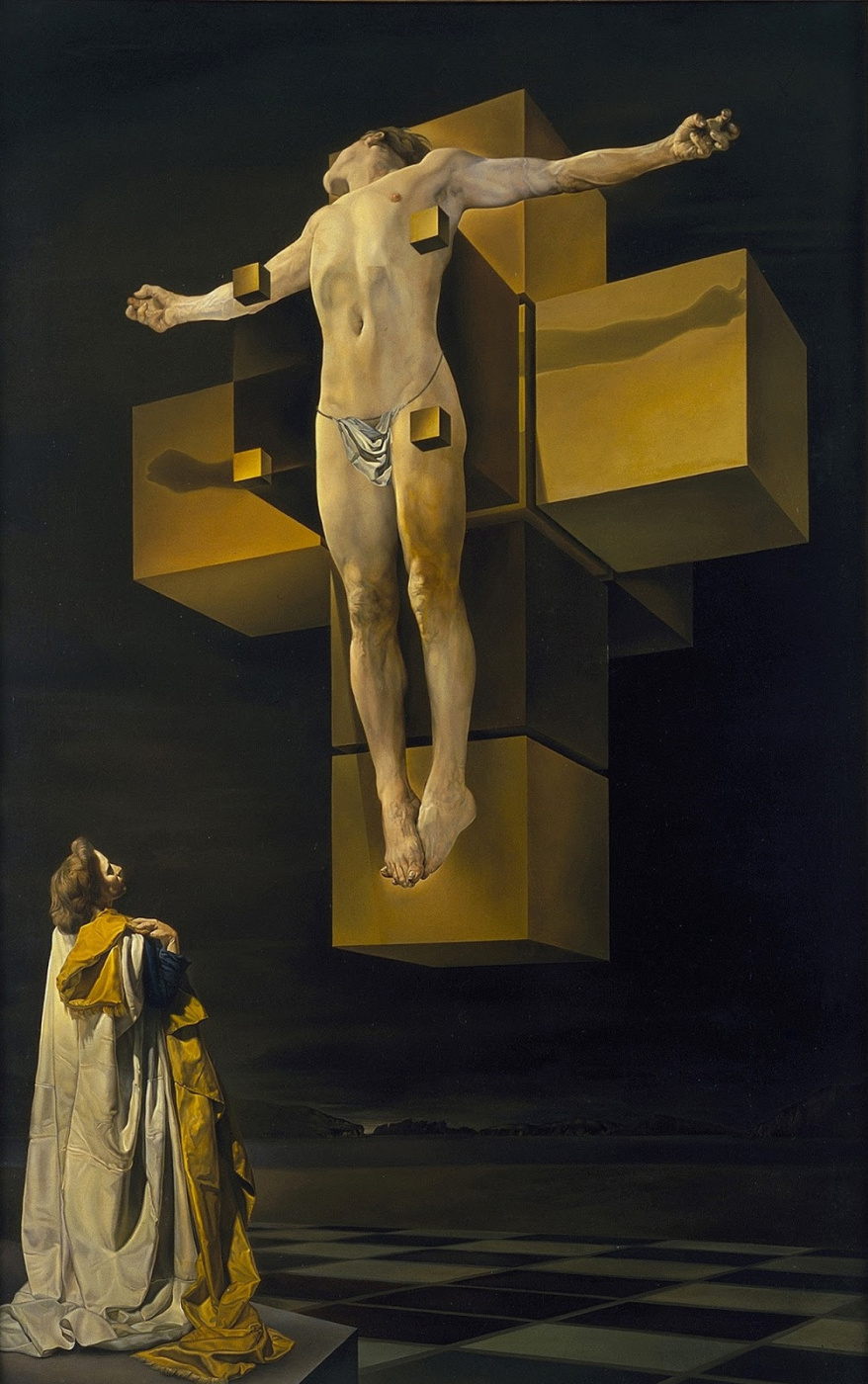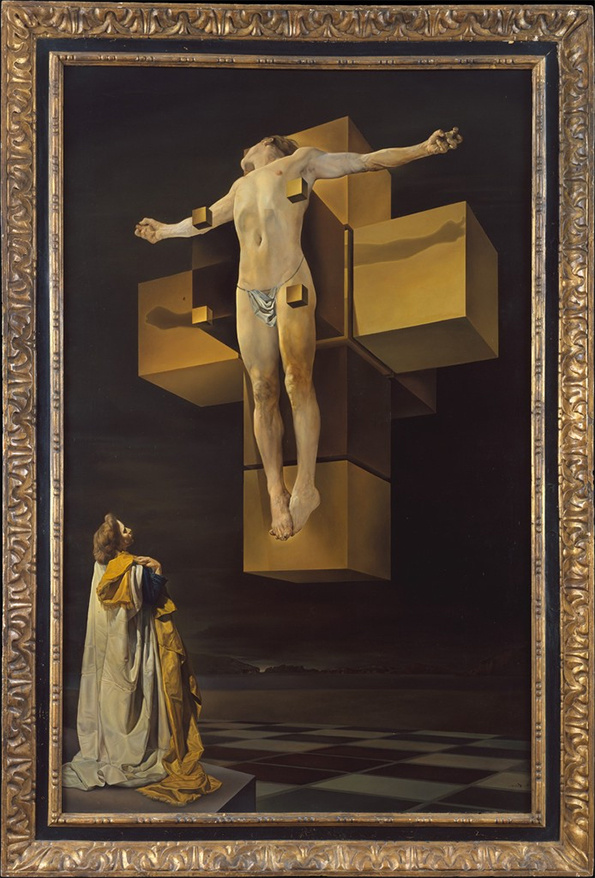log in
Enter site
Login to use Arthive functionality to the maximum
Crucifixion Hypercubic body
Salvador Dali • Painting, 1954, 195×124 cm
Description of the artwork «Crucifixion Hypercubic body»
Returning from New York on March 27, 1953 on the steamer America, Dali announced to the reporters gathered in the port of Le Havre that he was going to create a picture he himself called sensational - an exploding Christ, nuclear and hypercubic. He said that this will be the first painting, painted in classical technique and according to an academic formula, but in fact consisting of cubic elements. To a reporter who asked why he wanted to depict an exploding Christ, the artist replied: “I don't know yet. I have ideas first, and an explanation comes later. This painting will be the greatest metaphysical work of my summer. "
Dali began work in the late spring of 1953 in Port Lligat, but it is dated by the year of graduation - 1954. In December, she was exhibited at the Carstairs Gallery in New York. The painting can be considered one of his most significant religious works in the classical style, along with "Madonna of Port Lligata", "Christ of St. John of the Cross" and "The Last Supper", which is located in the National Gallery of Art in Washington.
Dali defined the style of the painting as “metaphysical transcendental cubism” and added: “It is based entirely on the Treatise on Cubic Form by Juan de Herrera, architect Philip II, builder of the Escorial Palace. This treatise is inspired by the work of Ars Magna (High Art) by the Catalan philosopher and alchemist Raymond Llull. The cross is formed by an octahedral hypercube. The number nine is recognizable and becomes emphatically consubstantial with the body of Christ. Gala's extremely noble figure represents the perfect union of the development of the hypercubic octahedron at the human level of the cube. She is depicted in front of the bay of Port Lligata. The noblest creatures have been written Velazquez and Zurbaran... I only approach nobility, drawing Gala, and nobility can only be inspired by man. "
Gala Dali looks at the crucifix as a reverent witness, wrapped in gold and white robes. She stands on a giant chessboard, and in the distance you can see the recognizable outlines of the Catalan mountains.
The Crucifixion is a stunning work that successfully combines elements of the “nuclear mysticism” that Dali became interested in at the time, with his appeal to the Catholic heritage. In this work, the artist depicts a crucifixion in the era of modern science, completing his theme, begun in the painting "Christ of St. John of the Cross".
Of particular note is the stunningly athletic figure of the crucified Savior. Even the nail holes in the palms and feet are missing as Dali presents us with his perfect atonement. The cross itself, an octahedral cube, is a possible theoretical reflection of a separate four-dimensional world. Dali's passion for mathematics is associated with his return to the Catholic faith in later years. This union demonstrates Dali's assertion that two seemingly diametrically opposed worlds of faith and science can coexist.
This two-meter painting is on the list of "Eighteen Masterpieces" compiled by Reynolds Morse, Dali's admirer and collector.
Dali began work in the late spring of 1953 in Port Lligat, but it is dated by the year of graduation - 1954. In December, she was exhibited at the Carstairs Gallery in New York. The painting can be considered one of his most significant religious works in the classical style, along with "Madonna of Port Lligata", "Christ of St. John of the Cross" and "The Last Supper", which is located in the National Gallery of Art in Washington.
Dali defined the style of the painting as “metaphysical transcendental cubism” and added: “It is based entirely on the Treatise on Cubic Form by Juan de Herrera, architect Philip II, builder of the Escorial Palace. This treatise is inspired by the work of Ars Magna (High Art) by the Catalan philosopher and alchemist Raymond Llull. The cross is formed by an octahedral hypercube. The number nine is recognizable and becomes emphatically consubstantial with the body of Christ. Gala's extremely noble figure represents the perfect union of the development of the hypercubic octahedron at the human level of the cube. She is depicted in front of the bay of Port Lligata. The noblest creatures have been written Velazquez and Zurbaran... I only approach nobility, drawing Gala, and nobility can only be inspired by man. "
Gala Dali looks at the crucifix as a reverent witness, wrapped in gold and white robes. She stands on a giant chessboard, and in the distance you can see the recognizable outlines of the Catalan mountains.
The Crucifixion is a stunning work that successfully combines elements of the “nuclear mysticism” that Dali became interested in at the time, with his appeal to the Catholic heritage. In this work, the artist depicts a crucifixion in the era of modern science, completing his theme, begun in the painting "Christ of St. John of the Cross".
Of particular note is the stunningly athletic figure of the crucified Savior. Even the nail holes in the palms and feet are missing as Dali presents us with his perfect atonement. The cross itself, an octahedral cube, is a possible theoretical reflection of a separate four-dimensional world. Dali's passion for mathematics is associated with his return to the Catholic faith in later years. This union demonstrates Dali's assertion that two seemingly diametrically opposed worlds of faith and science can coexist.
This two-meter painting is on the list of "Eighteen Masterpieces" compiled by Reynolds Morse, Dali's admirer and collector.



